
by Terri Cook and Lon Abbott Monday, August 24, 2015
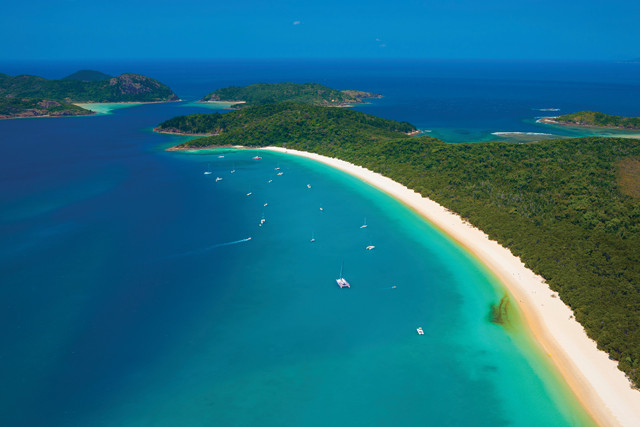
Whitehaven Beach on Whitsunday Island is perennially voted one of the top 10 beaches in the world. Credit: ©iStockphoto.com/Shane_Pedersen.
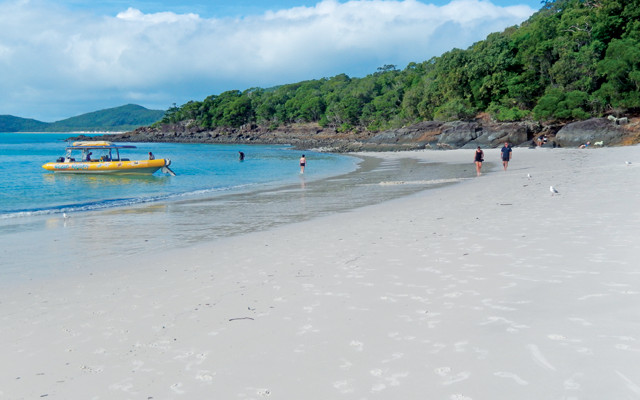
Whitehaven Beach is the only beach within all the Whitsunday Islands that has sand that is 99 percent pure quartz. Credit: Terri Cook and Lon Abbott.
In 2009, Tourism Queensland launched a campaign soliciting applications for what they billed as “the Best Job in the World”: “caretaker” of Australia’s Whitsunday Islands for six months. Benefits included transportation to Hamilton Island, the isles’ commercial hub, accommodation in a multimillion-dollar mansion and an extravagant salary. What responsibilities did the job entail? Mostly, it involved exploring the tropical paradise that is the Whitsunday Islands and documenting these explorations through photo diaries, blogs and web videos. Applications were only accepted by web video.
Tourism Queensland wasn’t alone in deeming this the best job in the world. Within two days of opening the competition, the website crashed under the weight of applications. By the time the dust settled, almost 35,000 people from more than 200 countries had applied. It isn’t hard to see why: One glance at a photo of Whitehaven Beach is likely all it took for most people to get to work on their applications. It was enough for us to add Whitsunday Island to our itinerary during our sabbatical in Australia last year, and it should be enough to stoke the interest of geo-travelers keen to experience one of the world’s most brilliantly white sand beaches.
It’s no wonder that Whitehaven Beach lands on just about everyone’s “Top 10 Beaches in the World” list, with 7 uninterrupted kilometers of powder-fine, whitewashed sand (that’s 99 percent quartz) fronting the clearest blue water you can imagine. That water stays at a delightful 26 degrees Celsius year-round, so the swimming is superb, as is the snorkeling at the beach’s southern end. Whitehaven is a wilderness beach: It’s located on the unpopulated Whitsunday Island and was ranked as the #1 Eco-Friendly Beach on the planet. Visitors reach it via a one-hour boat trip from either Hamilton Island or the laid-back mainland resort town of Airlie Beach.
No trip to Whitehaven Beach would be complete without making the short, forested hike up to Tongue Point Lookout to soak up the view. The long, narrow waterway of Hill Inlet lies between Tongue Point and Whitehaven Beach. The inlet is famous for its “swirling sands” — ever-shifting ridges of dazzling white sand wafted about by tidal currents. Beyond the inlet lies the narrow strip of pristine white beach separating azure water from verdant forest. If you crave more activity on your vacation than lazing on the beach, you can go bushwalking in the rainforest. Most visitors to Whitsunday Island are day-trippers, so if you pitch a tent in the campground nestled just behind the beach, you may wake up the next morning with a tropical paradise nearly all to yourself.
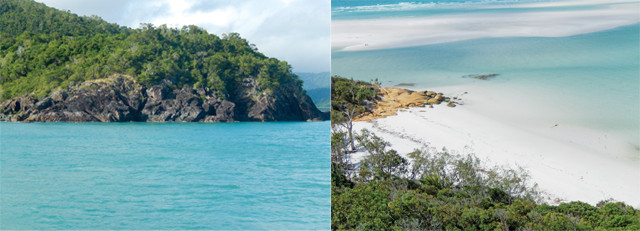
Outcrops in the Whitsundays show that weathering of the local rhyolite and dacite rocks could not have produced the beach's silky quartz sand (right). Credit: both: Terri Cook and Lon Abbott.
Whitsunday Island is the largest of 74 isles in the Whitsunday Group. Outstanding beaches abound on the other 73 islands, but only Whitehaven Beach has the distinctive brilliant-white quartz sand. The question of where Whitehaven’s sand came from has long been used as a tourism hook, with brochures claiming the sand’s source is a mystery that has stumped geologists for years. Although it is true that geologists haven’t worked out every detail of the story, in reality, it isn’t all that mysterious.
The Whitsunday Islands are all that remain of several volcanic calderas that erupted between 132 million and 95 million years ago during the breakup of Gondwana, when the microcontinent of Zealandia, now mostly submerged, was being torn away from Australia by rifting. The volcanic episode that accompanied the rifting was enormous; geologists estimate that roughly 2.5 million cubic kilometers of silica-rich magma were produced along the 2,500-kilometer-long rift. This volcanic pile is called the Whitsunday Silicic Large Igneous Province, or SLIP. This is the largest SLIP on the planet, although you’d never guess it by looking at the diminutive Whitsunday Islands today. Most of the volcanic rocks were carried away on Zealandia and are now submerged beneath the waters of the Tasman Sea, where rocks similar to those of the Whitsunday Islands have been recovered through deep-sea drilling. The rest of that immense volume is contained in the volcaniclastic sediment that fills the interior Great Australian Basin to the west.
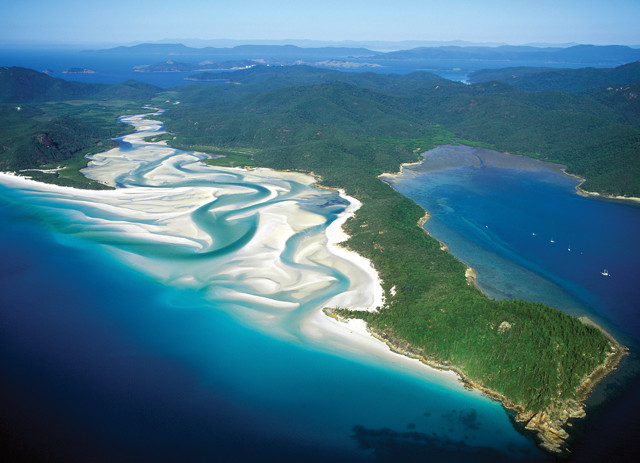
The long, narrow waterway of Hill Inlet is famous for its "swirling sands" — ever-shifting ridges of dazzling white sand wafted about by tidal currents. Credit: ©iStockphoto.com/ John Carnemolla.
The rocky outcrops on Whitsunday Island are remnants of this volcanism. But a quick examination of the rock at Tongue Point and the low outcrops near the south end of Whitehaven Beach shows that weathering of the local rhyolite and dacite rocks could not have produced the beach’s silky quartz sand; any quartz grains those rocks contain are microscopic. Whitehaven’s sand had to come from somewhere else.
Marine surveys have revealed that an enormous 1.85 billion tons of this sand reside in the Whitsunday area, all deposited there within the last 10,000 years. The story begins 12,000 years ago, when glaciers still covered much of Canada, Siberia and northern Europe. With so much water locked up as ice, global sea level then was much lower than it is today.
Today, Whitsunday Island is about 25 kilometers off the Queensland coast. But 12,000 years ago, the coast of Queensland — the interior of which has lots of exposed granite from which the 99-percent-quartz sand could weather — lay far to the east of the Whitsundays, close to the edge of today’s Great Barrier Reef. By about 10,000 years ago, the glaciers were almost completely melted, raising sea level in the process. As the water rose, Queensland’s coastline shifted westward, and by 8,000 years ago, modern Whitsunday Island lay along the mainland coast. About that time, longshore drift — a process in which currents moving along the shore operate like a conveyor belt for sand — delivered huge amounts of sediment to the future Whitsunday Island. Beaches form wherever an embayment, however tiny, allows sand to settle out of the longshore current, and the geometry of Whitehaven Beach was conducive to accumulating especially large quantities of that sand.
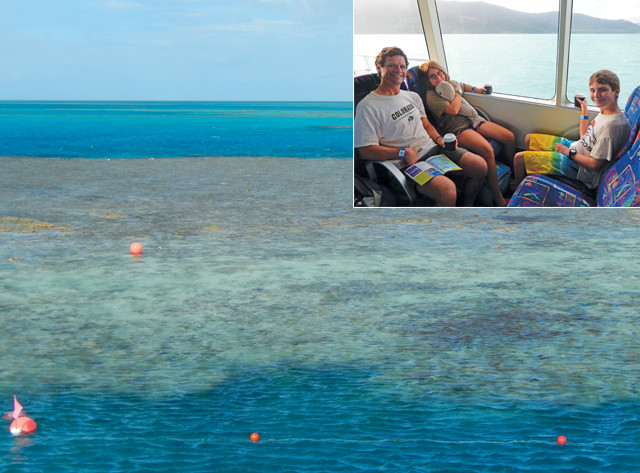
Excellent snorkeling spots also abound along the small reefs that fringe the 74 islands of the Whitsundays, but the underwater vistas get even better if you take a boat out to one of the pontoons anchored on the outer shoals of the Great Barrier Reef (main image). Credit: both: Terri Cook and Lon Abbott.
By 6,500 years ago, the ice-age glaciers had melted, sea level had reached its modern elevation, and the tops of the ancient calderas became the Whitsunday Islands. The longshore current shifted west, cutting off the islands’ sand supply. Since waves and tides keep sand ever on the move, the beaches that had accumulated small amounts of quartz sand lost it as time passed. But Whitehaven was so richly endowed that even though it has been losing sand for the last 4,500 years, there is still enough there to keep it blanketed.
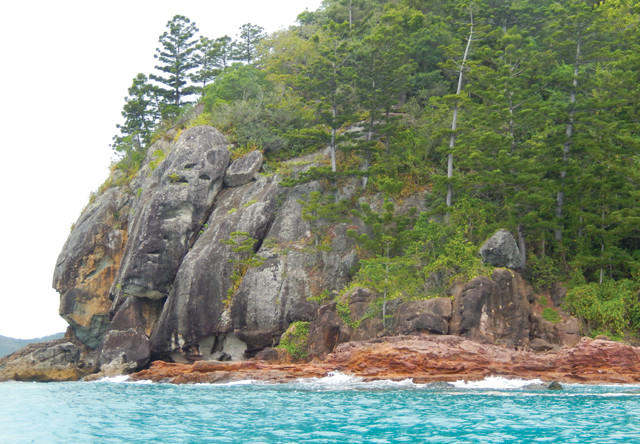
Snorkeling abounds in the Whitsundays, whether by cliffs or sandy or rocky beaches. Credit: Terri Cook and Lon Abbott.
Whitehaven Beach is only the beginning of the seaside fun to be had in the Whitsundays. The area is renowned for its world-class sailing. You can hire a boat and crew for a three-day cruise through the islands or, if you are an experienced sailor, you can rent and captain a boat yourself. Excellent snorkeling spots also abound along the small reefs that fringe the 74 islands, but the underwater vistas get even better if you take a day trip out to one of the pontoons anchored on the outer shoals of the Great Barrier Reef itself. Landlubbers can view the fish and coral from the pontoon’s underwater windows or a glass-bottomed boat. But to fully appreciate the vibrant colors present in this rainforest of the sea, you need to snorkel or dive, both of which are easy to do from the pontoon.
The view of the reefs from the air is also extraordinary, and brief helicopter tours to see the aptly named Heart Reef depart regularly from the pontoon and from Airlie Beach. Because we were fortunate to visit the pontoon at the low ebb of a spring tide, we were treated to the unusual spectacle of a whitewater rapid in the ocean. One of the reefs encloses a lagoon, the floor of which lies higher than the lowest low tides. During those times, the water in the lagoon flows down into the surrounding sea through a gap in the perimeter reef, in the process creating a rapid any river kayaker would be happy to run.
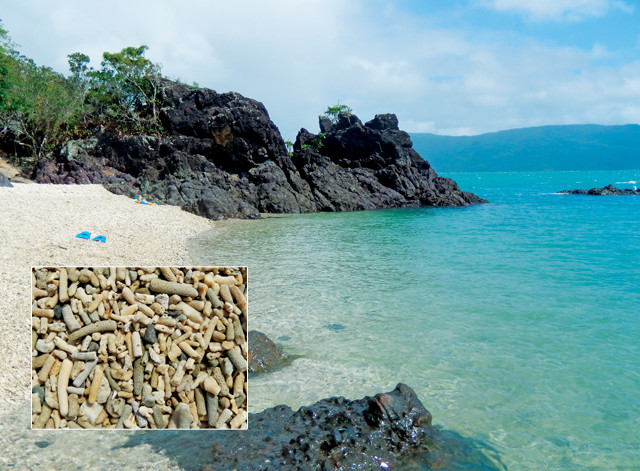
On Daydream Island, where the beaches are cobbly with chunks of coral (inset), visitors can swim and snorkel or relax at a large, resort-style pool. Credit: all: Terri Cook and Lon Abbott.
Our daughter loves rays of all kinds, so when she heard that you can feed stingrays (with the stinging barbs removed) at the resort on Daydream Island, we had to go. Our kids spent two hours giggling and smiling as they lined their starfish up for a race, fed and learned about many kinds of local fish, rays and sharks, and our son even kissed a sea cucumber (said to bring good luck). You can also feed fish in the ocean and swim at a cobble beach or in a large, resort-style pool.
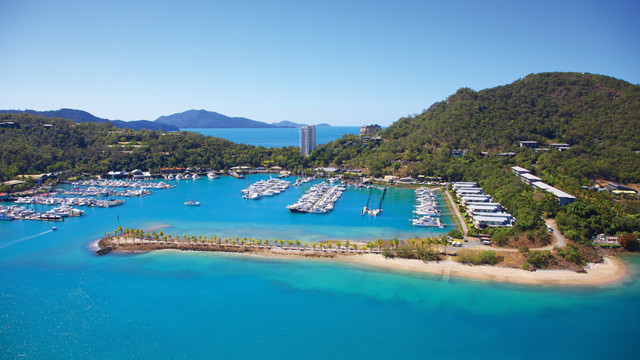
Many visitors to Whitsunday Island base their stay in Airlie Beach on mainland Queensland. Credit: ©iStockphoto.com/Tanya Puntti.
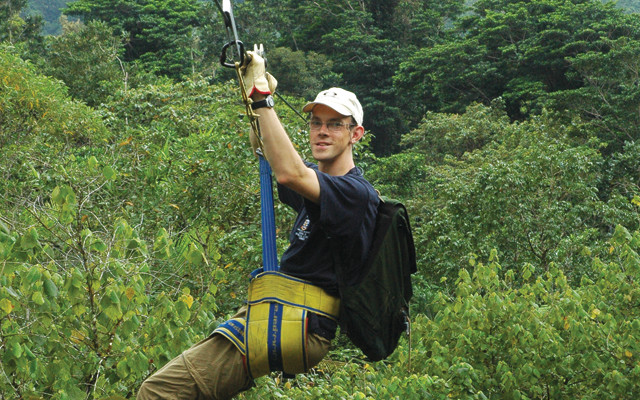
A popular activity in Finch Hatton Gorge is ziplining. Credit: ©Arthur, CC BY-NC-ND 2.0.
There is no question that the ocean and the coast are the Whitsundays’ main draw. But it’s worth carving out a day during your idyllic beach vacation to enjoy the enchanting interior of Queensland as well. Beautiful Finch Hatton Gorge, about 100 kilometers south of Airlie Beach, offers walks through the rainforest and a swimming hole beneath Araluen waterfall. If that seems too sedate, consider flying through the forest on a 340-meter-long zipline.
The pristine rainforest of mountainous Eungella National Park lies 20 kilometers north from Finch Hatton Gorge. Scientists think that this patch of rainforest was isolated by climate change about 30,000 years ago — this higher parcel of the rainforest was cut off by the lower, drier land around it as the climate dried out — leaving species there to evolve in unique ways. A favorite among this endemic menagerie is the Eungella gastric brooding frog, which gestates its eggs in its stomach. When it is time to give birth, the mother spits the tadpoles out of her mouth. The star of Eungella, though, is the platypus. One of only five species of monotremes, or egg-laying mammals (there are also four species of echidna), platypuses swim in lakes using their webbed feet. Eungella is one of the best places to see them in Australia, the only continent where monotremes live, but even here they are tough to see because they are nocturnal.
If you like your wildlife a bit wilder than platypuses and gastric brooding frogs, consider taking a crocodile tour out of Airlie Beach. This is the croc’s southernmost range; you have to go farther north to see the really big ones. But the specimens here are still plenty thrilling to see — just be sure to give them a wide berth.

Visitors can cool off in a freshwater swimming hole at the base of Cedar Falls, a short drive from Airlie Beach. Credit: Terri Cook and Lon Abbott.
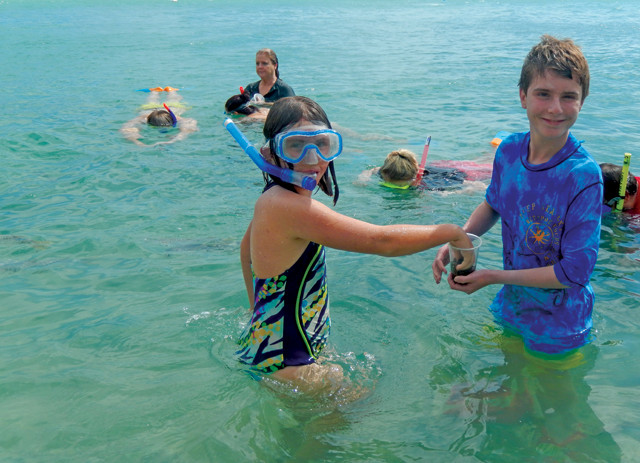
Visitors to Daydream Island can feed fish and rays, race starfish, and kiss a sea cucumber — said to bring good luck. Credit: Terri Cook and Lon Abbott.
So who was the lucky applicant whom Tourism Queensland hired to enjoy all this natural beauty? England’s Ben Southall became the islands’ “caretaker.” He enjoyed his time in paradise, but trouble visits even here; during his last week on the job, he was stung by an irukandji jellyfish. Such stings are sometimes fatal, but fortunately Ben made a full recovery, and he moved to Queensland permanently when the job ended. As for Tourism Queensland, they spent $1 million on the promotion, and experts calculate that they received $290 million worth of free publicity. The campaign was reprised in 2013, when Tourism Australia offered six of “the best jobs in the world” — one in each Australian state — for which another 330,000 people from 196 countries applied.
Queensland is unlikely to abandon such a successful marketing strategy, so get your application ready for the next time the promotion arises; it’s hard to argue that six months wandering through the diverse geology and ecology of Queensland’s Whitsunday Islands wouldn’t be just about the best job in the world.
© 2008-2021. All rights reserved. Any copying, redistribution or retransmission of any of the contents of this service without the expressed written permission of the American Geosciences Institute is expressly prohibited. Click here for all copyright requests.